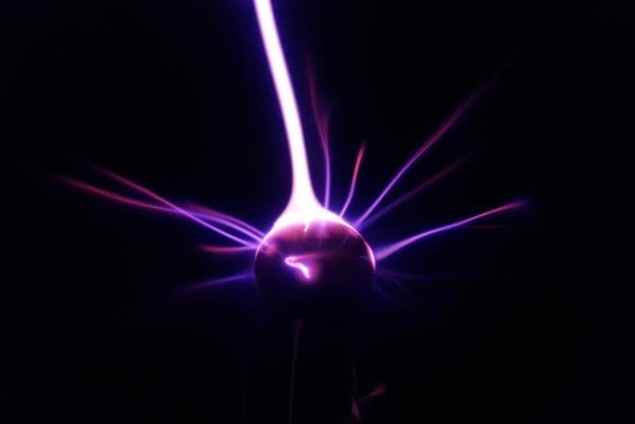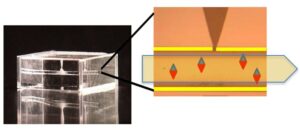
The first technique capable of measuring the pull of gravity on a particle just microns in diameter could aid the quest for a quantum theory of gravity – a longstanding goal in physics. The new experiment uses a superconducting quantum interference device (SQUID) to detect the force on the particle at ultralow temperatures and suppresses vibrations that might interfere with motion due to gravity.
Gravity differs from the other fundamental forces because it describes a curvature in space-time rather than straightforward interactions between objects. This difference explains, in part, why theoretical physicists have long struggled to reconcile gravity (as described by Einstein’s general theory of relativity) with quantum mechanics. One of the main sticking points is that while the latter assumes space-time is fixed, the former states that it changes in the presence of massive objects. Since experiments to determine which description is correct are extremely difficult to perform, a theory of quantum gravity remains out of reach despite much theoretical effort in areas such as string theory and loop quantum gravity.
Meissner-state field expulsion
In the new work, which is reported in Science Advances, physicist Tjerk Oosterkamp of Leiden University in the Netherlands, together with colleagues at Southampton University, UK and Italy’s Institute for Photonics and Nanotechnologies, probed the boundary between gravity and quantum mechanics by studying the pull of gravity on a magnetic particle with a mass of just 0.43 milligrams – near the limit where quantum effects start to appear. To perform their study, they trapped the particle in a magnetic field generated by passing current through wires that become superconducting at temperatures below 100 millikelvin. The resulting magnetic field “landscape” causes the particle to levitate thanks to a well-known superconducting effect known as Meissner-state field expulsion in which the field arising from currents in the superconductor completely opposes the particle’s own magnetic field.
Once the particle was levitating, the researchers measured very small changes in the magnetic field that arise when it moves around its centre of mass. They did this using an integrated DC SQUID magnetometer while continuously tuning the frequency of the magnetic trapping potential. This enabled them to characterize the amplitude of the particle’s motion as a function of these frequency shifts.
Suppressing vibrations
The researchers then created a gravitational disturbance by rotating a heavy wheel just outside the refrigerator, or cryostat, that contained the experiment. The rotation frequency of the wheel was tuned to excite one of the vibration frequencies of the levitated particle. But before they could measure changes in the particle’s motion due to this gravitational disturbance, Oosterkamp and colleagues first had to make sure that other things that could set the particle moving – such as vibrations coming from the compressor and pumps responsible for cooling the superconductor – were very well suppressed.
“That turned out the be the most pressing challenge in our experiment,” explains Oosterkamp, “but once we had succeeded in doing this, the motion of the particle that remained turned out to be so small that it was disturbed by gravity – and we could actually measure this.”
Pushing the boundaries
Oosterkamp and colleagues originally intended to use their cryostat to cool and excite a mechanical resonator. “We were doing this to try and prove that it could be in two places simultaneously – much in the way that an electron can be when it shows interference effects passing through two slits,” Oosterkamp explains. “From the interference, one infers that the electron is a wave and goes through both slits at once. For our experiment, which has still a long way to go, we have been working on isolating vibrations to cool down a force sensor to observe the same type of effect for a tiny mechanical resonator.”
These initial experiments went so well, he recalls, that they asked themselves: what is the smallest force they could exert on the particle in their set-up to demonstrate the sensitivity of the experiment? “When we realized that gravity measurements were in reach, we were especially motivated,” Oosterkamp recalls.
Experiment needs to be even more sensitive
The next step, Oosterkamp says, is to bring gravitational and quantum effects even closer together. “Being able to measure the gravitational force from a particle that is in two places at once would be very desirable, but we need to make our experiment even more sensitive to do this and make measurements on heavier objects that show quantum effects – like superposition and entanglement, for example,” he says.

Is quantum gravity slowing down neutrinos?
To this end, the researchers are working to replace the wheel outside their cryostat with a similar wheel or propeller inside it. “Instead of a wheel with kilogram-sized blocks on it and placed 30 cm away from the sensor, we hope to make milligram masses on a propeller that is just a centimetre away,” Oosterkamp says.
The team is also attempting to isolate external vibrations in their experiment even further and make their system colder. “These measures could improve measurement sensitivities by a 100-fold,” Oosterkamp says.
- SEO Powered Content & PR Distribution. Get Amplified Today.
- PlatoData.Network Vertical Generative Ai. Empower Yourself. Access Here.
- PlatoAiStream. Web3 Intelligence. Knowledge Amplified. Access Here.
- PlatoESG. Carbon, CleanTech, Energy, Environment, Solar, Waste Management. Access Here.
- PlatoHealth. Biotech and Clinical Trials Intelligence. Access Here.
- Source: https://physicsworld.com/a/getting-closer-to-measuring-quantum-gravity/
- :has
- :is
- :where
- 100
- 160
- 30
- 43
- a
- Able
- AC
- actually
- advances
- Aid
- also
- an
- and
- appear
- ARE
- areas
- arise
- arising
- around
- artist
- AS
- assumes
- At
- attempting
- away
- ball
- BE
- because
- become
- been
- before
- below
- between
- Blocks
- both
- boundary
- bring
- but
- by
- CAN
- capable
- causes
- centre
- challenge
- Changes
- characterize
- closer
- colleagues
- coming
- completely
- contained
- continuously
- Cool
- correct
- could
- created
- Current
- dc
- demonstrate
- described
- describes
- description
- Despite
- detect
- Determine
- device
- DID
- difference
- difficult
- do
- doing
- down
- due
- effect
- effects
- effort
- enabled
- end
- entanglement
- especially
- Even
- example
- experiment
- experiments
- Explains
- external
- extremely
- field
- First
- fixed
- For
- Force
- Forces
- Former
- Frequency
- from
- function
- fundamental
- further
- General
- General Theory of Relativity
- generated
- getting
- Go
- goal
- Goes
- gravitational
- gravity
- had
- Have
- he
- heavy
- hope
- http
- HTTPS
- if
- improve
- in
- information
- initial
- inside
- integrated
- intended
- interactions
- interfere
- Interference
- issue
- IT
- ITS
- jpg
- just
- known
- Levitate
- like
- LIMIT
- Long
- longstanding
- Magnetic field
- Main
- make
- Mass
- masses
- massive
- max-width
- measure
- measurement
- measurements
- measures
- measuring
- mechanical
- mechanics
- might
- more
- most
- motion
- motivated
- moves
- moving
- much
- Near
- Need
- needs
- Netherlands
- neutrinos
- New
- next
- objects
- observe
- of
- on
- once
- ONE
- or
- originally
- Other
- our
- out
- outside
- own
- part
- Passing
- Perform
- Physics
- Physics World
- Places
- plato
- Plato Data Intelligence
- PlatoData
- points
- potential
- presence
- pressing
- Prove
- pumps
- Quantum
- Quantum Mechanics
- quest
- rather
- reach
- realized
- relativity
- remained
- remains
- replace
- Reported
- researchers
- resembles
- responsible
- resulting
- s
- same
- says
- sensitive
- Sensitivity
- sensor
- set
- Shifts
- show
- Shows
- similar
- simultaneously
- since
- Slowing
- small
- So
- Southampton
- Space
- spikes
- start
- States
- Step
- sticking
- Still
- straightforward
- String
- Study
- Studying
- such
- superconducting
- superposition
- sure
- system
- team
- technique
- telescope
- than
- Thanks
- that
- The
- the Netherlands
- their
- Them
- themselves
- then
- theoretical
- theory
- These
- they
- things
- this
- Through
- thumbnail
- to
- together
- trapped
- trapping
- true
- try
- tuned
- tuning
- Turned
- two
- type
- Uk
- university
- use
- uses
- very
- was
- Wave
- Way..
- we
- WELL
- well-known
- went
- were
- What
- What is
- Wheel
- when
- which
- while
- why
- with
- Work
- working
- world
- would
- zephyrnet













